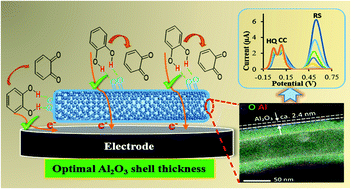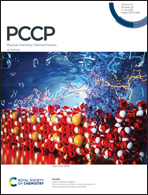CNT/Al2O3 core–shell nanostructures for the electrochemical detection of dihydroxybenzene isomers†
Abstract
We report CNT/Al2O3 core–shell nanostructures for the electrochemical detection of dihydroxybenzene (DHB) isomers. Amorphous films of Al2O3 (1.2–15.4 nm in thickness) are uniformly deposited onto the inner and outer walls of CNTs by atomic layer deposition. The effect of the Al2O3 shell thickness on the electrochemical detection of dihydroxybenzene isomers was explored using cyclic and square-wave voltammetry. The best sensing properties are found at a shell thickness of approx. 2.4 nm (CNT/Al2O3(9) sensor), where the oxidation peak currents (sensor-signal) increased ca. 10 times as compared to a sensor fabricated with non-coated CNTs. All of the three DHB isomers (hydroquinone, catechol and resorcinol) are independently detected in the concentration ranges of 2–1000 μmol L−1, 0.5–700 μmol L−1 and 3.5–500 μmol L−1, respectively. The sensors show reliable repeatability, reproducibility, long-term stability, and applicability in the analysis of real samples. Based on these findings, a plausible mechanism is proposed highlighting the role of the Al2O3–shell.



 Please wait while we load your content...
Please wait while we load your content...